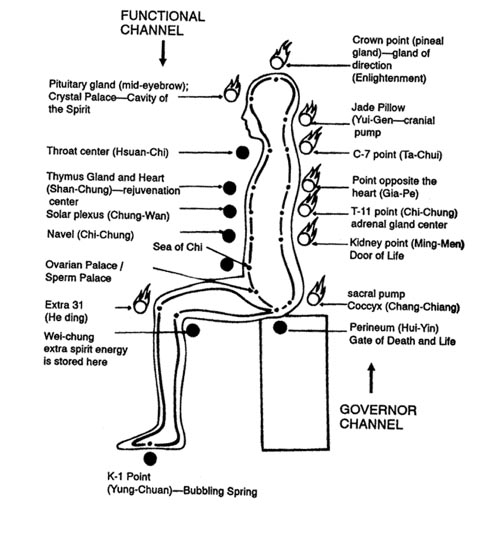
Diverse schools of spiritual thought flourished for thousands of years in India and China with innumerable descriptions of chakra awareness.
There are remarkable similarities between the two systems.
Numerous textbooks and articles describe these structures in detail. However, there are no clear agreements on every element of every chakra—number of petals, colors, feelings, functions, etc. Theories and personal experiences account for these differences. This narrative will describe the main physical and astral structures associated with each chakra, and how the chakras relate to each other in terms of Indian and Chinese postulates.
This basic definition will facilitate the discussion.
Chakra—Astral energy center closely associated with regional nerves, glands and organs.
Most Indian teachers concentrate on the spinal energy centers and consider them to be the chakras. The anterior energy centers are referred to as kshetrams. This is the prevailing view.
Though extremely popular, long-standing, and prevalent, this interpretation is only partially accurate and the following examples make the case for alternate considerations harmonious with Taoist philosophy.
When one falls in love, or has a broken heart, one feels it in the center of anahata, not in the spine.
When the martial artist feels the heat and power of chi, he/she feels it in the abdomen, not in the spine.
When one feels sexual attraction, mediated by swadhisthana, it occurs in the loins, not in the spine.
When one tastes the astral nectar of vishuddha, it is manifested in the throat and tongue, not in the spine.
When one sees the Light of ajna, it is definitely in front of the brain, not the back.
What are commonly referred to as spinal chakras are in fact trigger points from the anterior chakras. They are the kshetrams.
The author trained in an Indian system which focused on the chakras in their anatomical locations, with definitive characteristics and attributes very similar to the Taoists.
The chakras in the anterior part of the body communicate with muladhara (when fully extended) in the region of the spinal cord; and because of this powerful interaction it feels as though the chakras are in the spine itself!
The ancient Taoists were adepts in astral energy centers and pathways. The following drawing illustrates conceptual relationships of the chakras with Chinese nomenclature.

In the illustration, observe the sperm palace/ovarian palace. It is in the region of the reproductive organs, as is swadhisthana.
Observe how the Sea of Chi, the navel and the solar plexus are in the region of manipura.
Appreciate how the Thymus Gland and Heart Rejuvenation Center are anahata.
Compare the Throat Center and vishuddha.
Note the Crystal Palace and its relationship to ajna as an anterior entity.
Examine how the Cranial Pump and Sacral Pump are the upper and lower limits of muladhara.
Sahasrara is known as the Crown Point (Enlightenment) in the Chinese system.
The Taoists identified a line of astral energy extending through the anterior chakras from swadhisthana to manipura, thence to anahata, vishuddha and ajna. It is called the Functional (Female) Channel. This is the female aspect of the astral body—Ida.
Its counterpart posteriorly is muladhara. Though coiled in the spine at rest, when fully extended it is the exact counterbalance to Ida. Therefore, it is the male aspect of the astral body—Pingala. In the Chinese system it is called the Governor (Male) Channel. The Taoist yogis, like the Indian yogis, described how to reach Enlightenment through melding of the male and female astral energy pathways. Methods of doing so are possible when approached from this perspective.
Clearly the Chinese and Indian masters are describing the same energy centers with one major difference: most Indian schools teach chakra locations in the spine and their ‘analogs’ the kshetrams, are located anteriorly. The Chinese postulate that anterior energy centers (chakras) are in fact located anteriorly, and have their analogs (kshetrams) in the spine.
For example, Point Opposite the Heart is the kshetram of anahata; the Door of Life is the kshetram of manipura. Careful analysis will note the exquisite symmetry of the two systems though opposite in perception.
Viewing the Ida and Pingala in this manner reconciles many aspects of chakra awareness and assists the student in learning to meditate within the chakras. Techniques of moving astral energy through these pathways result in marked strengthening of the chakras and deeper levels of meditation.
Love elephant and want to go steady?
Sign up for our (curated) daily and weekly newsletters!
Apprentice Editor: Sue Adair/Editor: Rachel Nussbaum
Photo: Beth Middlecamp via Pixoto











Read 0 comments and reply